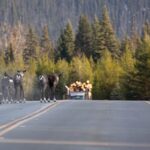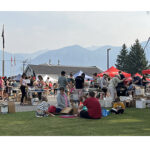Home »

New report refutes Jumbo’s economic benefits
A new economic benefits study of the Jumbo Glacier Resort proposal is refuting the conclusions of the Environmental Assessment Office (EAO) that the project will provide economic benefits to the Province of B.C.
Prepared by the Ktunaxa Nation Council (KNC) and Marvin Shaffer & Associates Ltd., ‘An Assessment of the Economic Benefits of the Proposed Jumbo Glacier Resort Project’ concludes, “There is no analysis or estimates to support the conclusion of the executive director of the EAO that the project is in the public interest because of the economic benefits it offers.”
The report was prepared for the KNC, which has today renewed its call for the provincial government to disallow the estimated $1 billion, three-season ski resort proposal for the upper Jumbo Creek Valley, 55 km west of Invermere.
“The purpose of this report is to assess the economic benefits of the proposed Jumbo Glacier project, consistent with the principles of benefit-cost analysis,” notes the work prepared and written by Dr. Marvin Shaffer and associates, with research assistance from Rob Nuttall and Kirsty Smith of Meyers Norris Penny LLP.
“Part of Dr. Shaffer’s assignment involved the review of economic benefits information considered by the BC Environmental Assessment Office in their review of the project, which concluded in 2004,” explained the KNC in an email to e-KNOW.
“There is no basis to conclude there would be net benefit for the Province of British Columbia if this resort is approved. The market growth forecasts underlying the proponent’s feasibility studies are out-dated; they do not reflect current market conditions or outlooks. The employment impact estimates are overly optimistic and do not recognize the extent to which tourism at Jumbo Glacier would divert visitors from other resorts. Nor do they consider where the workers would come from and what benefit that would offer British Columbians. Many of the new jobs would be filled by in-migrants as the ski industry already has to recruit international workers from abroad. There would be costs for government providing the services the in-migrants and the project itself would require. Overall there is simply no evidence of net benefits – certainly no evidence there would be net benefits that would justify the adverse impacts the project would have,” stated Shaffer, who has a Ph.D. in economics from the University of British Columbia. In addition to extensive consulting experience, Dr. Shaffer has held senior positions with the Government of British Columbia and is currently an Adjunct Professor at Simon Fraser.
Representatives with Glacier Resorts Ltd. and Pheidias Project Management were contacted prior to the official release of the Shaffer Report with an invitation to comment on its contents but they did not respond before e-KNOW’s deadline.
The following is the bulk of the executive summary of Shaffer’s report, beginning with an assertion that employment creation does not equal economic benefits.
“Employment impacts do not measure economic benefits. The economic benefits of the jobs created as a result of a project depend on the social or opportunity cost of labour – the wages the workers would otherwise have earned or the value of the activity they would otherwise have engaged in. The economic benefits also depend on the incremental as opposed to total number of jobs created – that is, the net increase in employment with versus without the project taking impacts on other resorts and business into account.
“Government revenue impacts similarly do not measure economic benefits. The economic benefits to government depend on the incremental revenues generated by a project (i.e., the increase in revenues due to the project relative to what government would otherwise receive) less the incremental expenditures government incurs.
“Neither the proponent in its Master Plan or other reports nor the Environmental Assessment Office in its review considered key factors governing the economic benefits of the Jumbo Glacier project. There is no analysis or estimates to support the conclusion of the executive director of the EAO that the project is in the public interest because of the economic benefits it offers.”
Jumbo Glacier Resort (JGR) has been kicking around the central Purcell Mountains for two decades now – with plans to ski glaciers on Glacier Dome and adjacent peaks, over a 20 year period and three phases. JGR is forecasting 70,000 winter skier visits in the first year of operation, increasing to 141,100 by the end of Phase 1 (year five) and 500,410 by year 20.
Shaffer’s report notes, “The assumed average growth rates are very high: 19% per year from year one to year five; 11% per year through to year 20. Even higher growth rates are assumed for the number of overnight visitors because of a forecast shift from predominately local (i.e., residents from the surrounding or nearby communities of the ski resort) to non-local visitors.
“Independent assessments of the financial feasibility of the project undertaken for the EAO in 1999 and 2004 questioned the basis and validity of these market forecasts. Recent market trends suggest there is even more reason to question them today. Overnight and skier visitor data indicate that there is a downward trend in the number of visitors from the important U.S. and Japanese markets; the trend in the number of skier visits in Canada and British Columbia is relatively flat; and an increasing proportion of skiing activity is by locals.
“The recent trends do not support the high rate of growth and shift from local to non-local visitors assumed for Jumbo Glacier. It is consequently not clear when and if the project would proceed to the second and third phases of development. In any event, with lower growth rates, the impacts of the project would be markedly less than what was presented in the proponent’s reports.”
Shaffer’s report also points out the flimsiness of assumptions in the proponent’s Master Plan report.
“The proponent estimated that the initial phase of construction would support a workforce of 50-70 and generate $12 to $14 million in income. Operations would support 250-350 full time jobs by year five and 865 at full build out. The proponent reported that industry average earnings in ski operations were $20,000 per year. Based on the forecast number and origin of visitors, and their average spending per day, the total economic impact was estimated at $32 million per year. The proponent’s impact estimates implicitly assume that all of the visitor spending is incremental – would not otherwise be spent in the region.
“That is clearly incorrect. Spending by local and regional visitors at Jumbo Glacier would leave less disposable income to spend at other resorts or for other goods and services. Very little of their spending would be incremental to the region, province and country as a whole. The incremental spending and consequent impacts would be much less than the gross impacts presented in the proponent’s reports, which in themselves are likely overstated because of the market forecast on which they were based.
“Whatever the incremental employment impact, the economic benefit depends on the opportunity cost of the workers hired, which in turn depends on what they would otherwise be doing. Significant benefits will only arise if the workers’ opportunity cost is low relative to the wages they receive, for example if they would otherwise be involuntarily unemployed.
“The proponent did not estimate the opportunity cost of the labour that would be hired as a result of its project. It did, however, provide information on the nature and average wages of the jobs that would be created, as well as economic conditions in the Kootenay region.
“Unemployment rates were high in the Kootenays when the proponent’s impact assessments were undertaken. Since then they have been cyclical, falling in the middle of the past decade and returning to relatively high levels since the financial crash of 2008. The key issue is what they are likely to be in the future when the project would be developed and operated.
“Labour market analysts and studies indicate that there will be a large number of job openings in the next decade; labour shortages are expected throughout B.C., including the Kootenay region. The creation of new jobs is more likely to result in in-migration than the hiring of local or even B.C. residents who would otherwise be involuntarily unemployed. Already ski resorts throughout the province are having to recruit internationally to fill the positions they have. Given this labour market outlook, there is no reason to believe, or evidence to suggest that there would be significant economic benefits associated with any new jobs generated by the project.
“The proponent estimated that there would be $11.4 million in tax revenues generated each year as a result of the project: $6.4 million to the federal government, $3.4 million to the province, and $1.6 million locally. The proponent did not estimate what the incremental revenues to government would be or what the net benefit would be after taking incremental expenditures into account.
“There would be some incremental tax revenues generated by the project resulting from new property development, income or other taxes paid by in-migrants and the rental payments paid in accordance with the province’s All Season Resort Policy. However, these would be much smaller than the gross revenue impacts presented by the proponent.
“While there would be some incremental revenues, there would be incremental government expenditures to provide services required as a result of the in-migration and the road or other infrastructure improvements and maintenance required by the project. The proponent indicated it would contribute to the infrastructure costs in accordance with consistently applied government policy. Based on experience with road improvements elsewhere, that could leave significant costs borne by government.
“The net impact on government is unclear. With no estimate of incremental revenues or incremental costs, there is no basis to conclude there would be a net benefit for government. Land and resource use impacts can give rise to benefits or costs to other resource users and interests. The proponent did not estimate the magnitude of these benefits or costs but did assess the nature and significance of the impacts.”
“The most significant land use impact would be the displacement of existing heli-ski operations, an impact the heli-ski operator (RK Heli-Skiing) maintained would be devastating for its business, but an independent assessment undertaken for the EAO suggested could be largely mitigated by relocation and joint marketing and access initiatives with Jumbo Glacier.
“With respect to other recreational resource impacts, there would be both benefits and costs – benefits due to the enhanced access to high alpine recreation afforded by the project; costs due to the loss of remote wilderness opportunities. Both would be limited by the controls on access outside the resort area that would be implemented.
“There would some impacts on primary resource industries – a loss of some forest base and mineral staking opportunity. The direct impacts would be very small. Significant costs would only result if there were visual management restrictions imposed on operations or other activity, something that the proponent has agreed not to pursue but could be pursued by others.
“The land and resource use benefits and costs are likely to be relatively small. As with the employment and government impacts, there is no basis to conclude there would be any overall net benefit due to the project.
This is the third assessment conducted on the Jumbo proposal, and the second that has cast a doubting light on the economic benefits posed by the two decades old proposal.
In September 1998, the EAO hired Brent Harley & Associates to complete an assessment of the implications of the proponent’s resort on RK Heli-Ski’s operations. RK president and owner Roger Madson maintained up to his death 10 years ago that his 30-year-old company could not withstand the loss of his tenured terrain in the Jumbo area and could not operate in conjunction with the resort proposal as suggested by project mastermind Oberto Oberti.
A report was filed in November 1999 with two notable conclusions.
“In their current state, RK and the proposed resort cannot exist and operate together – at best, a fair weather heli-skiing operation could co-exist with the proposed resort; and there is no available replacement terrain of a similar size and nature to the area that would be lost to RK if the proponent’s resort was to proceed, that could be offered to RK as mitigation.” The following was culled from: https://www.jumboglacierresort.com/documents/docs/SierraSys-RKheli-Report.pdf .
In 2004 the Sierra Systems Group Inc. was hired by the EAO and the proponent to look into RK’s claims and it concluded: “Should the proponent’s application be approved, we would expect no material impact to occur to RK’s operations, as RK has reasonable opportunities to mitigate impacts by making better use of other regions of its tenure, notably the Glacier and Tenise areas.
“While a compensable impact will likely not occur, the conditions of approving the proponent’s application should specifically confirm the Proponent’s responsibility to mitigate the disruption to RK’s operations caused by the new resort.
“Given a current high level of acrimony between the proponent and RK, we recommend the institution of a formal process whereby the Proponent must offer “co-existence opportunities” similar to those set out in correspondence. The province should engage a mediator to facilitate the process and to ensure the proponent presents bona fide options for RK to consider.”
For more on Dr. Marvin Shaffer go to: https://www.bchydro.com/etc/medialib/internet/documents/rev_reqs_bch/pdf/apr2004_e_bcoapo_m_shaffer_resume_pdf.Par.0001.File.apr2004_e_bcoapo_m_shaffer_resume.pdf
For more on Glacier Resort Ltd. and its plans go to: https://www.jumboglacierresort.com/
Ian Cobb/e-KNOW







